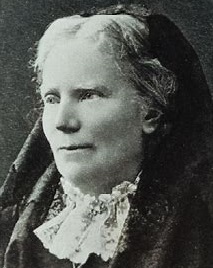 In the mid-1800s, it was unheard of for a woman to be a doctor. They were barely allowed to be a nurse, although they were somehow expected to be able to do all the “nursing” duties for their own family. Elizabeth Blackwell was born February 3, 1821 and she was about to change things forever. She first became a physician in England, and then she became the first woman to receive a medical degree in the United States, and the first woman on the Medical Register of the General Medical Council. I’m not a big “women’s libber,” but sometimes women need to decide what they want to do in life, and go for it. Elizabeth Blackwell played an important role in both the United States and the United Kingdom as a social awareness and moral reformer. She promoted education for women in medicine.
In the mid-1800s, it was unheard of for a woman to be a doctor. They were barely allowed to be a nurse, although they were somehow expected to be able to do all the “nursing” duties for their own family. Elizabeth Blackwell was born February 3, 1821 and she was about to change things forever. She first became a physician in England, and then she became the first woman to receive a medical degree in the United States, and the first woman on the Medical Register of the General Medical Council. I’m not a big “women’s libber,” but sometimes women need to decide what they want to do in life, and go for it. Elizabeth Blackwell played an important role in both the United States and the United Kingdom as a social awareness and moral reformer. She promoted education for women in medicine.
Strangely, Blackwell was not interested in a career in medicine at first. In fact, when her schoolteacher brought in a bull’s eye to use as a teaching tool, Blackwell found that she didn’t feel so well. So, initially, she became a schoolteacher in order to support her family. Teaching school was one of the few “acceptable” occupations for women during the 1800s. Unfortunately for her, she hates every minute of teaching, but she found that medicine and medical subjects did interest her.
Her interest in medicine began after a friend fell ill and told her that, if a female doctor had cared for her, she 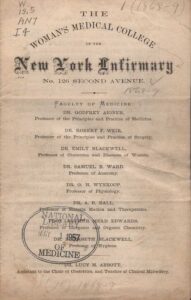 might not have suffered so much. Blackwell decided then and there that she would go to medical school. She began applying to medical schools and immediately found out that there was a prejudice against women students of medicine. In fact, there was no such thing, and the school and other students intended to keep it that way. That prejudice against her gender would persist throughout her career, but it did not stop her.
might not have suffered so much. Blackwell decided then and there that she would go to medical school. She began applying to medical schools and immediately found out that there was a prejudice against women students of medicine. In fact, there was no such thing, and the school and other students intended to keep it that way. That prejudice against her gender would persist throughout her career, but it did not stop her.
She was rejected from every medical school she applied to, except Geneva Medical College, currently known as State University of New York Upstate Medical University. Amazingly, her acceptance came after the male students voted for her acceptance. And so it was that in 1847, Elizabeth Blackwell became the first woman to attend medical school in the United States. Her inaugural thesis on typhoid fever was published in 1849 in the Buffalo Medical Journal, shortly after she graduated. It was the first medical article ever published that had been written by a woman female student from the United States. In what was considered a perspective that was deemed by the medical community as feminine, the thesis “portrayed a strong sense of empathy and sensitivity to human suffering, as well as strong advocacy for economic and social justice.”
In 1857, Elizabeth Blackwell founded the New York Infirmary for Women and Children with her sister Emily Blackwell, and began giving lectures to female audiences on the importance of educating girls. She also played a significant role during the American Civil War by organizing nurses. Her contributions remain celebrated with the Elizabeth Blackwell Medal, which is awarded annually to a woman who has made significant contribution to 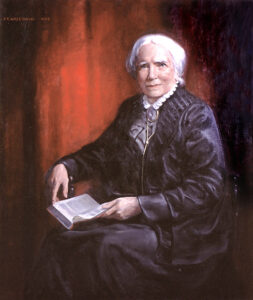 the promotion of women in medicine. Blackwell remained active even into her later years. In 1895, she published her autobiography, Pioneer Work in Opening the Medical Profession to Women. It was not very successful, selling less than 500 copies. After this publication, Blackwell slowly relinquished her public reform presence, and spent more time traveling. She visited the United States in 1906 and took her first and last car ride.
the promotion of women in medicine. Blackwell remained active even into her later years. In 1895, she published her autobiography, Pioneer Work in Opening the Medical Profession to Women. It was not very successful, selling less than 500 copies. After this publication, Blackwell slowly relinquished her public reform presence, and spent more time traveling. She visited the United States in 1906 and took her first and last car ride.
While holidaying in Kilmun, Scotland in 1907, Blackwell fell down a flight of stairs, and was left almost completely mentally and physically disabled. On May 31, 1910, she died at her home in Hastings, Sussex, after suffering a stroke that paralyzed half her body. Her ashes were buried in the graveyard of Saint Munn’s Parish Church, Kilmun, and obituaries honoring her appeared in publications such as The Lancet and The British Medical Journal.
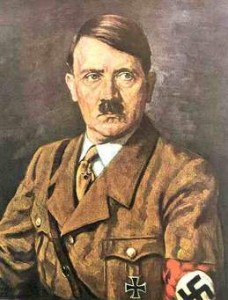 When Hitler began his reign of terror, he fully expected that he would meet with little resistance from the people he was attempting to control, but that really never turned out to be the case. Even some of those who aligned themselves with him at first, rebelled later. Hitler found that out when, on November 18, 1940, he met with Italian Foreign Minister Galeazzo Ciano over Mussolini’s disastrous invasion of Greece.
When Hitler began his reign of terror, he fully expected that he would meet with little resistance from the people he was attempting to control, but that really never turned out to be the case. Even some of those who aligned themselves with him at first, rebelled later. Hitler found that out when, on November 18, 1940, he met with Italian Foreign Minister Galeazzo Ciano over Mussolini’s disastrous invasion of Greece.
Mussolini had led Hitler to believe that he had no intention of attempting to invade Greece. Then, he surprised everyone with a attempted invasion of Greece. Even his ally…Hitler, was caught off guard, since Mussolini had led Hitler to believe he had no such intention. Even Mussolini’s own chief of army staff only found out about the invasion after the fact!!
Mussolini was warned against trying to invade Greece. Everyone around him knew that the Greek people were determined to hold onto their freedom, and that the Italian Army was woefully unprepared for such an attack. Even his own generals warned of a lack of preparedness on the part of his military. Nevertheless, and despite the fact that it would mean getting bogged down in a mountainous country during the rainy season against an army willing to fight tooth and nail to defend its autonomy, Mussolini moved ahead mostly out of sheer arrogance, convinced he could defeat the “inferior Greeks” in a matter of days. He also knew a secret, that millions of Lire (The primary unit of currency in Italy, Malta, San Marino, and the Vatican City before the adoption of the Euro) had been put aside to bribe Greek politicians and generals not to resist the Italian invasion. The whole bribe idea didn’t work out too well, however. Whether the money ever made it past the Italian fascist agents delegated with the responsibility is unclear, but if it did, it clearly made no difference. The Greeks pushed the Italian invaders back into Albania after just one week. The whole operation was a miserable failure, and the Italians spent the next three months fighting for life in a fierce, defensive battle. To make matters worse, about half the Italian fleet had been crippled by a British carrier-based attack at Taranto.
A furious Hitler severely criticized Ciano at their meeting in Obersalzberg, for opening an opportunity for the British to enter Greece and establish an airbase in Athens. That put the Brits within striking distance of valuable 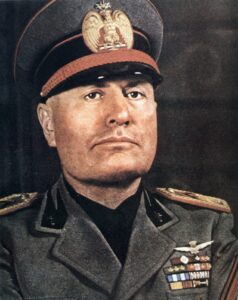 oil reserves in Romania that Hitler needed for his war machine. Hitler now had to divert forces from North Africa, a high strategic priority, to Greece in order to bail Mussolini out. He actually considered leaving the Italians to fight their own way out of the mess, and considered making peace with the Greeks as a way of forestalling an Allied intervention. Nevertheless, Germany would have to invade, in April 1941, thereby adding Greece to its list of conquests…whether Hitler wanted to or not. That put the Brits within striking distance of valuable oil reserves in Romania that Hitler needed for his war machine. Hitler now had to divert forces from North Africa, a high strategic priority, to Greece in order to bail Mussolini out. He actually considered leaving the Italians to fight their own way out of the mess, and considered making peace with the Greeks as a way of forestalling an Allied intervention. Nevertheless, Germany would have to invade, in April 1941, thereby adding Greece to its list of conquests…whether Hitler wanted to or not.
oil reserves in Romania that Hitler needed for his war machine. Hitler now had to divert forces from North Africa, a high strategic priority, to Greece in order to bail Mussolini out. He actually considered leaving the Italians to fight their own way out of the mess, and considered making peace with the Greeks as a way of forestalling an Allied intervention. Nevertheless, Germany would have to invade, in April 1941, thereby adding Greece to its list of conquests…whether Hitler wanted to or not. That put the Brits within striking distance of valuable oil reserves in Romania that Hitler needed for his war machine. Hitler now had to divert forces from North Africa, a high strategic priority, to Greece in order to bail Mussolini out. He actually considered leaving the Italians to fight their own way out of the mess, and considered making peace with the Greeks as a way of forestalling an Allied intervention. Nevertheless, Germany would have to invade, in April 1941, thereby adding Greece to its list of conquests…whether Hitler wanted to or not.
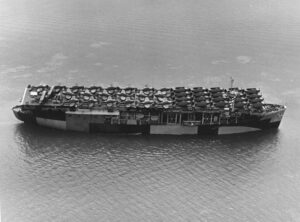 When I think of bravery, the “Woolworth Carriers” come to mind as one group of many. In the second half of World War II, the so dubbed “Woolworth Carriers” were escort carriers that were clumsy, slow, and without armor, and yet, they lead the way in dangerous waters for the American and British navies. The ships were versatile, unsung workhorses, and the men who served on them were heroes in every way. There is no way these men could have thought that they were ever safe from attack…they were a virtual target, and they knew it.
When I think of bravery, the “Woolworth Carriers” come to mind as one group of many. In the second half of World War II, the so dubbed “Woolworth Carriers” were escort carriers that were clumsy, slow, and without armor, and yet, they lead the way in dangerous waters for the American and British navies. The ships were versatile, unsung workhorses, and the men who served on them were heroes in every way. There is no way these men could have thought that they were ever safe from attack…they were a virtual target, and they knew it.
The so-called “Woolworth Carriers” shepherded convoys, hunted submarines, supported amphibious landings, and ferried men and planes in the Atlantic, the Mediterranean, the Pacific, and the Arctic at a time when U-Boats were seemingly everywhere. Although mocked as the “Woolworth Carriers,” and also called by other more “unprintable names,” the “combustible, vulnerable, and expendable” ships performed a gallant and vital role in the Allied crusade against fascist tyranny. And they did it very much unprotected.
The concept of these “Jeep” flattops and ocean-going “Model Ts” dated back to the mid-1930s. The boats were called by many names, most of them intended to be almost insulting. They were a part of a time when America, Great Britain, and Japan were investigating the possibility of converting merchant ships into small aircraft carriers. I suppose it could have been almost an innovation that had simply not seen its time yet. The idea for these ships was first initiated during World War I. As early as 1935, the United States Navy’s Bureau of Construction and Repair studied the possibility of converting 10 passenger liners for military use, and they drew up plans for taking “quick action” in the event that a war emergency created the need for such vessels. Of course, the planes of World War I were much smaller, so that part of the idea now made no sense. By 1935, the Navy was already building a powerful fleet of big flattops ships to accommodate the larger planes, so the proposals for auxiliary carriers were soon put aside. Navy Secretary Frank Knox told the United States Maritime Commission in late 1940, “The characteristics of aircraft have changed, placing more exacting demands upon the carrier. These demands are such that a converted merchant vessel can no longer make as satisfactory an aircraft carrier as was the case when the plans for those vessels were being drawn.” British Prime Minister Winston Churchill saw the auxiliary flattops’ potential for quickly replenishing the Royal Navy’s crippling combat carrier force losses, although I don’t know how these small ships could help anything. President Franklin D Roosevelt also liked the concept, thanks to the influence of shipbuilder Henry J Kaiser. Shipyards owned by Kaiser were ready to gear up for wartime production.
FDR proposed the experimental acquisition and conversion of a merchant ship of 6,000 – 8,000 tons displacement, to Admiral Harold R. “Betty” Stark, chief of naval operations. The plans called for the “carrier” to be fitted with a flight deck and equipped with about 10 helicopters or 10 planes with low landing speed. Stark and his aides went to work through January 1941 on Roosevelt’s proposal, one requirement of which was that the merchantman selected for conversion should have a sister ship that could be similarly converted for use by the British, who had been at war for a year and a half. On January 7, the Maritime Commission advised the Navy Department that the two C-3 diesel-powered cargo ships Mormacmail and Mormacland. Both ships were 492 feet long and 9,000 tons, and would be made available for conversion to carriers. The conversion project was estimated to take 18 months, but FDR imposed a deadline of three months instead. Stark actually finished a little under the three month deadline.
Acquired for conversion on March 6, Mormacmail’s was recommissioned on June 2, as USS Long Island (CVE-1). Long Island was not used in combat, but did ferried aircraft to Pearl Harbor shortly after the Battle of Midway and carried 19 Grumman F-4F Wildcat fighters and a dozen Douglas Dauntless SBD dive-bombers to Espiritu Santo for use on Guadalcanal in late August 1942. The Navy used her to train carrier pilots and ferry troops for the rest of the war. The converted Mormacland was turned over to the Royal Navy as HMS Archer on November 17, 1941. It was the first of 39 American-built escort carriers provided under the Lend-Lease program, and it did serve in the Battle of the Atlantic.
Four more merchant hulls were rebuilt into escort carriers for the British, and made ready for service in the spring and summer of 1942. They were Avenger, Biter, Dasher, and Charger. The United States Navy rescinded the Lend-Lease transfer order for the Charger, which was commissioned on March 3, 1942, as its second escort carrier. Ironically, the first Allied escort carrier to see combat was of enemy origin. The 5,527-ton, 15-knot German merchant ship Hannover was captured in the West Indies in March 1940 by a British light cruiser and a 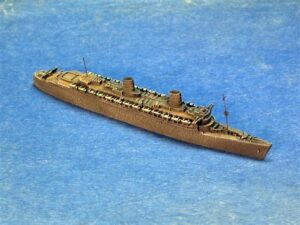 Canadian destroyer. The ship was recommissioned in June 1941 and renamed HMS Audacity in July,. The ship had its superstructure removed and replaced with a stem-to-stern, 475-foot flight deck.
Canadian destroyer. The ship was recommissioned in June 1941 and renamed HMS Audacity in July,. The ship had its superstructure removed and replaced with a stem-to-stern, 475-foot flight deck.
Once in service, Audacity and its half-dozen Wildcat fighters (called Martlets in the Royal Navy) proved to be so effective at protecting Mediterranean convoys that Nazi U-boat chief Admiral Karl Dönitz felt compelled to pay rueful tribute to the “continuous air umbrella” the ship maintained. Shortly after ferrying survivors of the sunken fleet carrier HMS Ark Royal, Audacity was torpedoed by a U-boat on the night of December 19. The skipper, Commander D W McKendrick, and 75 officers and men died.
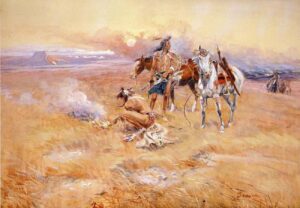 With the many annual wildfires that continue to consume many of the western areas of the United States each year, we begin to wonder if there is any way to stop the madness. Of course, these days, firefighters knw about mitigation, “a series of steps that you can take to reduce the risk of a wildfire consuming your property. It includes assessing the risks around your property, recognizing the wildfire dangers and your responsibility in mitigating them, thereby creating a defensible space. It involves how and where you store materials around your property, considering the health of your trees to determine the need for trimming or removal, as well as designating 3 zones of protection (0-30’, 30-100’, 100’+) in your defensible space.” That’s how we would help to stop the threat of fire these days, but where did we even learn about this. I can’t say for sure, but we can look to the American Indians for some possible clues.
With the many annual wildfires that continue to consume many of the western areas of the United States each year, we begin to wonder if there is any way to stop the madness. Of course, these days, firefighters knw about mitigation, “a series of steps that you can take to reduce the risk of a wildfire consuming your property. It includes assessing the risks around your property, recognizing the wildfire dangers and your responsibility in mitigating them, thereby creating a defensible space. It involves how and where you store materials around your property, considering the health of your trees to determine the need for trimming or removal, as well as designating 3 zones of protection (0-30’, 30-100’, 100’+) in your defensible space.” That’s how we would help to stop the threat of fire these days, but where did we even learn about this. I can’t say for sure, but we can look to the American Indians for some possible clues.
For centuries, Europeans and Americans thought or at least claimed to have thought that the myth that Native Americans were solely hunter-gatherers who didn’t know how to make the most of the land was a reality. That really isn’t the case at all, but the story gave the White settlers, permission to have every right to take over large parcels of land, on the premise that it would have gone to waste otherwise. I’m sure it seemed like a 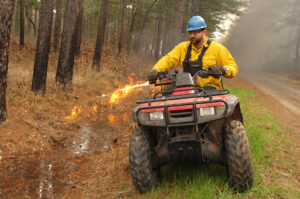 logical way to get more land, and the settlers didn’t see the Indians as really using the land anyway, but then did the settlers really know anything about the land. I don’t think so.
logical way to get more land, and the settlers didn’t see the Indians as really using the land anyway, but then did the settlers really know anything about the land. I don’t think so.
The idea that the Indians didn’t really know how to work the land is a total misrepresentation of the complex relationship between Indigenous communities and their land. In reality the Native Americans were actually farmers with extensive agricultural experience. In fact, it was the Pilgrims who struggled to survive after they arrived what is now Massachusetts. The locals…the Wampanoag were the ones who actually taught them how to farm. Strangely, one of the most innovative and effective land-management strategies of the Wampanoag people was “cultural burning,” which is igniting small, controlled fires that burn away old, dry vegetation to make room for new life. Cultural Burning sounds a whole lot like the fire mitigation practices of today. Of course, it is different, but in some ways, it is also the same. While the exact steps are not the same, the outcome can be very much the same.
Cultural burning reduced the chance of large fires that would kill people and food sources, including the animals that the Indians hunted, and the natural food sources they depended on. When we neglect fire mitigation practices, we open the area up to highly dangerous fires that destroy homes and kill people every year. The fire 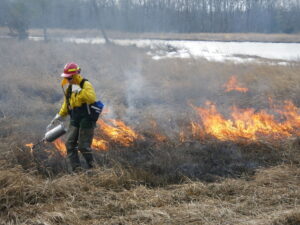 mitigation practices are different these days, but just like the protections the Indians used, the current fire mitigation practices could save lives, if they were properly carried out. The result of improper fire mitigation or even a ack of fire mitigation can be seen in the many annual wildfires we see in places like present day California…sadly. Though the practice of cultural burning was stopped in the 19th and 20th centuries, it’s coming back into practice in some areas, especially as conservationists understand its value in preventing more devastating, larger wildfires. Wildfires can’t spread in areas of controlled burns. When vegetation has already been burned away in controlled blazes, wildfires have fewer places to spread.
mitigation practices are different these days, but just like the protections the Indians used, the current fire mitigation practices could save lives, if they were properly carried out. The result of improper fire mitigation or even a ack of fire mitigation can be seen in the many annual wildfires we see in places like present day California…sadly. Though the practice of cultural burning was stopped in the 19th and 20th centuries, it’s coming back into practice in some areas, especially as conservationists understand its value in preventing more devastating, larger wildfires. Wildfires can’t spread in areas of controlled burns. When vegetation has already been burned away in controlled blazes, wildfires have fewer places to spread.
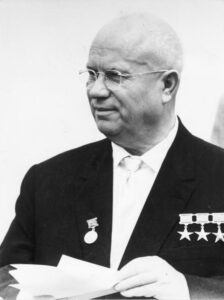 It’s never a good idea to find your nation behind it’s enemies in the arms race. Never was that made more clear than during the Cold War. It’s also not a good idea to begin to brag to your enemies about the superiority of your nation over theirs concerning the nation’s arms race status. Nevertheless, in a long and rambling interview with an American reporter on November 15, 1957, Soviet leader Nikita Khrushchev claimed that the Soviet Union had missile superiority over the United States. He then went on to challenge America to a missile “shooting match” to prove his assertion. It was a bold move, and one that fueled fears in the United States that the nation was indeed falling behind the Soviets in the arms race. People began to worry about not only the idea of the United States falling behind in the arms race, but also the idea that the Soviet Union and Nikita Khrushchev might actually launch their missiles at the US.
It’s never a good idea to find your nation behind it’s enemies in the arms race. Never was that made more clear than during the Cold War. It’s also not a good idea to begin to brag to your enemies about the superiority of your nation over theirs concerning the nation’s arms race status. Nevertheless, in a long and rambling interview with an American reporter on November 15, 1957, Soviet leader Nikita Khrushchev claimed that the Soviet Union had missile superiority over the United States. He then went on to challenge America to a missile “shooting match” to prove his assertion. It was a bold move, and one that fueled fears in the United States that the nation was indeed falling behind the Soviets in the arms race. People began to worry about not only the idea of the United States falling behind in the arms race, but also the idea that the Soviet Union and Nikita Khrushchev might actually launch their missiles at the US.
Khrushchev tried to compare the arms race to the space race, saying that if the United States had intercontinental ballistic rockets, “she had would have launched her own Sputnik.” Khrushchev was crossing boastful belligerence and calls for “peaceful coexistence” with the West, in what was a classic move for him. He bragged about Soviet missile superiority, claiming that the United States did not have what the Soviet Union had. Then, as cool as a cucumber, he issued a challenge, saying, “Let’s have a peaceful rocket contest just like a rifle-shooting match, and they’ll see for themselves.”
Following his fear-inspiring statements, Khrushchev began to speak about the future of East-West relations, saying that the American and Soviet people both wanted peace. He cautioned that although the Soviet Union would never start a war, “some lunatics” might bring about a conflict. In particular, he noted that Secretary of State John Foster Dulles had created “an artificial war psychosis.” In the case of war, it “would be fought on the American continent, which can be reached by our rockets.” NATO forces in Europe would also be devastated, and Europe “might become a veritable cemetery.” While the Soviet Union would “suffer immensely,” the forces of communism would ultimately destroy capitalism.
Khrushchev made these remarks just a few days after the Gaither Report had been leaked to the press in the 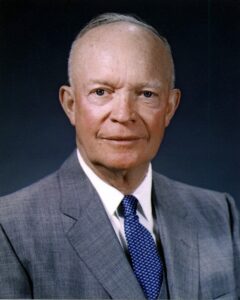 United States. The report supported many of the Russian leader’s contentions, charging that the United States was falling far behind the Soviets in the arms race. Of course, the critics of President Dwight D Eisenhower’s foreign policy, especially the Democratic Party, went on the attack, calling Eisenhower weak. The Gaither Report called for “an urgent strengthening of US missile technology, along with offensive and defensive military capabilities. The report also called for a fifty percent increase in US military spending and a redesign of the US Defense Department.” The Gaither Report was presented to President Eisenhower on November 7, 1957. The report suggested that Eisenhower’s military policy…the reliance on cheap nuclear weapons instead of expensive Army divisions…was inadequate. He kept the Report secret and generally ignored it, but its conclusions were leaked to the press. The public debate concerning the alleged “missile gap” between US and Soviet rocket arsenals continued through the early 1960s and became a major issue in the 1960 presidential campaign between Richard Nixon and John F Kennedy.
United States. The report supported many of the Russian leader’s contentions, charging that the United States was falling far behind the Soviets in the arms race. Of course, the critics of President Dwight D Eisenhower’s foreign policy, especially the Democratic Party, went on the attack, calling Eisenhower weak. The Gaither Report called for “an urgent strengthening of US missile technology, along with offensive and defensive military capabilities. The report also called for a fifty percent increase in US military spending and a redesign of the US Defense Department.” The Gaither Report was presented to President Eisenhower on November 7, 1957. The report suggested that Eisenhower’s military policy…the reliance on cheap nuclear weapons instead of expensive Army divisions…was inadequate. He kept the Report secret and generally ignored it, but its conclusions were leaked to the press. The public debate concerning the alleged “missile gap” between US and Soviet rocket arsenals continued through the early 1960s and became a major issue in the 1960 presidential campaign between Richard Nixon and John F Kennedy.
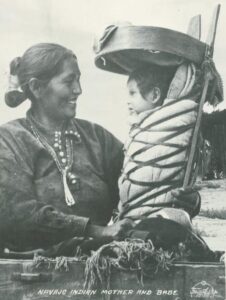 When we look at the different nationalities and cultural groups, one thing that seems always to stay the same…difference. These groups always have their own ideas about milestones that should be celebrated. Where many people might celebrate things like the baby’s first tooth, rolling over, smile, word, crawling, steps, and such, the Navaho Indian tribes in the Southwestern United States, who call themselves Diné, have a very different idea of what should be celebrated. This tribe have picked up on the most fun part of life, as the reason for celebration…that first laugh.
When we look at the different nationalities and cultural groups, one thing that seems always to stay the same…difference. These groups always have their own ideas about milestones that should be celebrated. Where many people might celebrate things like the baby’s first tooth, rolling over, smile, word, crawling, steps, and such, the Navaho Indian tribes in the Southwestern United States, who call themselves Diné, have a very different idea of what should be celebrated. This tribe have picked up on the most fun part of life, as the reason for celebration…that first laugh.
We all know how great it is to hear a baby laugh for the first time. It’s great fun, and if you happened to be the one to coax that first laugh out of the baby, it’s even more fun. The Navajo believe that a baby’s first laugh demonstrates their readiness and willingness to fully join their families in life and love. The Navajo people believe that the person who makes the child laugh is also very special. That person is given a great gift…they get to plan the party. It is that tradition, and it stipulates that the person who provoked the baby’s laugh hosts a ceremony and dinner to mark the occasion. The party is called a First Laugh Ceremony (A’wee Chi’deedloh). According to Navajo national Jaclyn Roessel, “This whole ceremony is really meant to show the baby how we’re supposed to be as Diné, as very generous people.”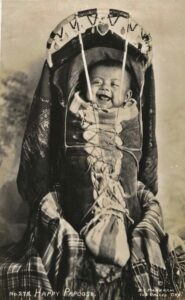
When I first learned about the tradition, I thought…naïvely so, that it could almost be viewed as a “punishment” for being the one that made the child laugh…depending on the financial status of the person or the size of the family that would be invited. Of course, that is silly. The Navajo people consider it an honor to be that one that brought the laughter. They become very special. I suppose it could almost be like becoming the child’s godparent. In the Navajo tradition, it goes deeper than that. The Navajo believe that newborn babies first live in the world of the Diyin Dine’e, the Holy People. Tradition has it that they stay in this temporary place before they can join their earthly families. As the tradition continues, the Diyin Dine’e are the first people, subjects of the most important myths and stories in Navajo culture. When a baby is first born, the Navajo believe the child lives among the Holy People, until the first time the baby laughs. The act of laughing is a sign the child is transitioning from the spirit world with the Diyin Dine’e and is ready to fully join his or her family in life. This might seem far-fetched, but many people believe that babies and children have the unique ability to see Jesus and the angels. In fact, in Christian belief, many people believe that these children, when they are seen specking to an “imaginary” friend, are actually speaking to Jesus or to their angels. The two beliefs are not really that different. I believe that the “holy people” are, in fact, Jesus and his angels.

Because of the significance that a baby’s first laugh holds in Navajo tradition, family members watch, wait, and listen intently to hear that first utterance of a giggle. Parents, siblings, cousins, grandparents, and just about anyone who is close to the family will try their best to get that first laugh, from silly faces to tickles, and everything in between. I guess they have already planned fo any cost and are already planning the whole thing in their heads. Then, when that special time arrives, when that precious first laugh comes, it’s time to celebrate the journey to their earthly family and welcome this new life into the community with a Navajo First Laugh Ceremony!!
 A full year before Nevado del Ruiz, the highest active volcano in the Andes Mountains of Colombia, erupted on November 13, 1985, the mountain began to show warning signs. The people living in the surrounding area, especially the town of Armero, were warned of a pending eruption, but a year is a long time to wait for a predicted eruption to occur, and after a while, the people began to consider the warnings to be false alarms. After a time, life went back to “business as usual” as the people believed the warnings were like a predicted blizzard that never materializes.
A full year before Nevado del Ruiz, the highest active volcano in the Andes Mountains of Colombia, erupted on November 13, 1985, the mountain began to show warning signs. The people living in the surrounding area, especially the town of Armero, were warned of a pending eruption, but a year is a long time to wait for a predicted eruption to occur, and after a while, the people began to consider the warnings to be false alarms. After a time, life went back to “business as usual” as the people believed the warnings were like a predicted blizzard that never materializes.
When the predicted eruption began on November 13, 1985, the people though they had been right, and the area had dodged a bullet, because the eruption was actually considered a mild one. The eruption produced a series of lava flows that surged over the volcano’s broad ice-covered summit. the super-heated lave became flowing mixtures of water, ice, pumice, and 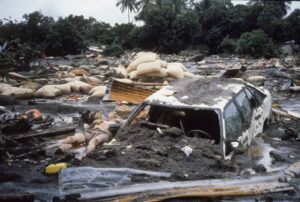 other rock debris that poured off the summit and sides of the volcano, forming “lahars” that flooded into the river valleys surrounding Ruiz. A lahar is a destructive mudflow on the slopes of a volcano. The lahars joined normal river channels, filling them to flood levels. To make matters worse the situation was exacerbated by heavy rain. Within four hours of the eruption, the lahars had traveled over 60 miles, killing more than 23,000 people, injuring over 5,000, and destroying more than 5,000 homes. The town of Armero was the hardest hit, losing three quarters of its 28,700 inhabitants. The lahars destroyed everything in their paths: roads, bridges, farm fields, aqueducts and telephone lines. They wiped out 50 schools, two hospitals, in addition to the more than 5,000 homes. The region lost 60 percent of its livestock, 30 percent of grain and rice crops, and half a million bags of coffee. 7,500 people were left homeless.
other rock debris that poured off the summit and sides of the volcano, forming “lahars” that flooded into the river valleys surrounding Ruiz. A lahar is a destructive mudflow on the slopes of a volcano. The lahars joined normal river channels, filling them to flood levels. To make matters worse the situation was exacerbated by heavy rain. Within four hours of the eruption, the lahars had traveled over 60 miles, killing more than 23,000 people, injuring over 5,000, and destroying more than 5,000 homes. The town of Armero was the hardest hit, losing three quarters of its 28,700 inhabitants. The lahars destroyed everything in their paths: roads, bridges, farm fields, aqueducts and telephone lines. They wiped out 50 schools, two hospitals, in addition to the more than 5,000 homes. The region lost 60 percent of its livestock, 30 percent of grain and rice crops, and half a million bags of coffee. 7,500 people were left homeless.
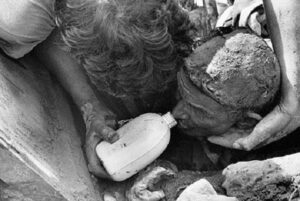
Because there had been ample warning, the losses could have been minimal, if the people living in the river valley had moved to higher ground. It’s not completely their fault. We humans, have a tendency to lose faith in what we have been told, when thing don’t happen immediately. After a year of hearing that the volcano was going to erupt, people began to think that the vulcanologists were wrong. Then, when it did start, it didn’t seem to be the horrendous eruption that had been predicted. All this led to a lack of a feeling of urgency, and thereby, they death of 23,000 people. So very sad that we could so carelessly refuse to take heed.
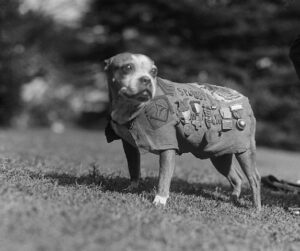 One day in 1917, a stray pit bull mix wandered onto the Yale University campus. Normally this would have meant a call to the local dog pound, but the dog rather attached himself to members of the 102nd Infantry Regiment, who were training at the school that day. While it was a bit unorthodox, the lost pup fit right in. He “volunteered” to participate in drills and quickly learned to salute with his right paw. He really seemed to want to enlist in the Army. The antics and intelligence of the dog quickly won the heart of Private James Robert Conroy, who decided to adopt the dog. He named the dog Stubby, because of his short, stubby tail. When it came time for the unit to ship out, Private Conroy couldn’t leave Stubby behind, so he smuggled him on board the troop ship. As they were getting off the ship in France, he hid Stubby under his overcoat…somehow without detection again. When Conroy’s commanding officer finally did discover Stubby, there might have been trouble, but Stubby saluted him, just as he had been trained to in camp, and the commanding officer couldn’t resist. He allowed the dog to stay on board.
One day in 1917, a stray pit bull mix wandered onto the Yale University campus. Normally this would have meant a call to the local dog pound, but the dog rather attached himself to members of the 102nd Infantry Regiment, who were training at the school that day. While it was a bit unorthodox, the lost pup fit right in. He “volunteered” to participate in drills and quickly learned to salute with his right paw. He really seemed to want to enlist in the Army. The antics and intelligence of the dog quickly won the heart of Private James Robert Conroy, who decided to adopt the dog. He named the dog Stubby, because of his short, stubby tail. When it came time for the unit to ship out, Private Conroy couldn’t leave Stubby behind, so he smuggled him on board the troop ship. As they were getting off the ship in France, he hid Stubby under his overcoat…somehow without detection again. When Conroy’s commanding officer finally did discover Stubby, there might have been trouble, but Stubby saluted him, just as he had been trained to in camp, and the commanding officer couldn’t resist. He allowed the dog to stay on board.
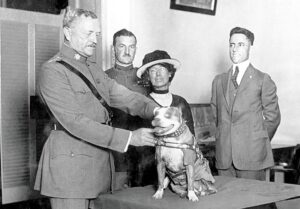
Stubby was a soldier all the way. He didn’t enlist to sit around and do nothing. While in France, in the trenches, Stubby was exposed to mustard gas. “Mustard gas or sulfur mustard is a chemical compound belonging to the sulfur-based family of cytotoxic and blister agent chemical warfare agents known as sulfur-mustards or mustard agents. The name mustard gas is widely used, but it is technically incorrect: the substance does not actually vaporize into a gas, but instead disperses as a fine mist of liquid droplets.” After Stubby recovered, he returned to the frontlines with his own specially-designed gas mask. The exposure to the mustard gas, combined with a dog’s heightened sense of smell, allowed Stubby to warn the 102nd of imminent poison gas attacks. Stubby also learned how to locate wounded soldiers during patrols, a very important part of his job. While technically a mascot, Stubby earned the rank of sergeant after he spotted a German spy and attacked the stunned man until reinforcements arrived. In his 18 months of service, Stubby participated in 17 battles, survived a series of wounds, and provided a much-needed boost to the morale of his fellow soldiers.
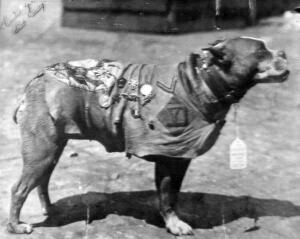
When World War I was over, Sergeant Stubby, as a decorated hero made his way back to the United States with Conroy. By this time, the dog now outranked his owner, and had become a national icon. Sergeant Stubby was invited to lead parades and was given awards until his death in 1926. Stubby died in his sleep on March 16, 1926. After his death he was preserved via taxidermy and his cremains were sealed inside of the mount. In 1956, Conroy decided to present Stubby to the Smithsonian. The taxidermy mount of the dog is part of the permanent collection at the Smithsonian National Museum of American History. It is currently on display in their “Price of Freedom: Americans at War” exhibit.
 Our Veterans…the cream of the crop. The strong and the brave. Those ones, with courage to last for days. We really cannot say enough about our brave fighting mem and women, who are willing to give up time with family and friends, to go out and fight, sometimes giving their lives so that other people…often unknown to them can live free. There should be a day to honor them. How could we not have such a day? It would be unthinkable. And so, today, we honor them. Those who served and came home again…some to face disability, PTSD, and sadness over the ones who didn’t make it home. We honor them, because they did what we were unable to do. While we sit at home, hopefully praying for our fighting men and women, they bravely took to the battleground, in the air, on land, and sea. Yes, not all served in wartime, but at any moment, all of them knew that it could become wartime.
Our Veterans…the cream of the crop. The strong and the brave. Those ones, with courage to last for days. We really cannot say enough about our brave fighting mem and women, who are willing to give up time with family and friends, to go out and fight, sometimes giving their lives so that other people…often unknown to them can live free. There should be a day to honor them. How could we not have such a day? It would be unthinkable. And so, today, we honor them. Those who served and came home again…some to face disability, PTSD, and sadness over the ones who didn’t make it home. We honor them, because they did what we were unable to do. While we sit at home, hopefully praying for our fighting men and women, they bravely took to the battleground, in the air, on land, and sea. Yes, not all served in wartime, but at any moment, all of them knew that it could become wartime.
I can’t say what it is that makes a soldier, because each probably has their own reasons for enlisting, but 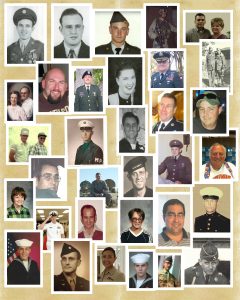 before they become a soldier, each has to make a decision that they will serve their country and willingly go wherever they are told, often without having a say in the matter. Some assignments are great, taking the soldier and family to exotic places, but some are so dangerous that the soldier cannot take his/her family along because it would be unsafe for them. Still, dangerous or not, the soldier bravely goes, and tries to be a credit to his/her uniform.
before they become a soldier, each has to make a decision that they will serve their country and willingly go wherever they are told, often without having a say in the matter. Some assignments are great, taking the soldier and family to exotic places, but some are so dangerous that the soldier cannot take his/her family along because it would be unsafe for them. Still, dangerous or not, the soldier bravely goes, and tries to be a credit to his/her uniform.
I am very proud of our veterans. They have served this country proudly. They took orders when they knew it could mean they lose their lives. That is a rare thing these days, when civil unrest is the norm. Many people would never consider a life or even an enlistment period, because they don’t think they would be appreciated. They don’t want to risk coming home only to be vilified, when in reality, they are the heroes. Veterans Day is a day to celebrate the soldiers who faced it all, and came back home to their families. To all of you…thank you for your service, and Happy Veterans Day!!

 Babies are always so much fun, and that is what my great grand-niece, Reece Balcerzak is about to find out, as she gets ready to meet her new little brother, Aysa Bruce Bowen Balcerzak, who made his appearance on November 8, 2021. Aysa weighed 7 pounds 5 ounces, and he was 19 inches long. Aysa was a little more cooperative than his big sister, in that he only arrived Just over two weeks early, while his big sister arrived just over two months early, after her mom and dad stayed at Presbyterian Saint Luke’s Hospital in Denver for two weeks trying to buy a little bit of time for baby Reece. Then she had to be in the hospital in Denver for the next 60 days before she was big enough and healthy enough to go home. With the problems his big sister had, Aysa’s parents were a little apprehensive when they found out they were pregnant again. They had just about decided that they would a “one and done,” as little Aysa’s daddy, Keifer Balcerzak said, when Aysa’s mom, Katie Balcerzak told his daddy that she was pregnant. They were excited, but also a little worried that they would have a repeat of their daughter’s birth. In the end, Aysa wasn’t in quite as big a hurry to get here as his sister was…thankfully.
Babies are always so much fun, and that is what my great grand-niece, Reece Balcerzak is about to find out, as she gets ready to meet her new little brother, Aysa Bruce Bowen Balcerzak, who made his appearance on November 8, 2021. Aysa weighed 7 pounds 5 ounces, and he was 19 inches long. Aysa was a little more cooperative than his big sister, in that he only arrived Just over two weeks early, while his big sister arrived just over two months early, after her mom and dad stayed at Presbyterian Saint Luke’s Hospital in Denver for two weeks trying to buy a little bit of time for baby Reece. Then she had to be in the hospital in Denver for the next 60 days before she was big enough and healthy enough to go home. With the problems his big sister had, Aysa’s parents were a little apprehensive when they found out they were pregnant again. They had just about decided that they would a “one and done,” as little Aysa’s daddy, Keifer Balcerzak said, when Aysa’s mom, Katie Balcerzak told his daddy that she was pregnant. They were excited, but also a little worried that they would have a repeat of their daughter’s birth. In the end, Aysa wasn’t in quite as big a hurry to get here as his sister was…thankfully.
Aysa is a sweet little boy who is a joy to his parents, but in the beginning the early tests said that he was going to be a girl. His parents began preparing for a second daughter, and then…when the ultrasound was done, Aysa had pulled off a surprise of his own. I guess, that his surprise was a little easier to deal with that Reece’s had been, because hers was downright dangerous, while his was a few little changes. I mean, you can’t go around putting your little boy in little girl clothes. Well, I guess you could, but he might not appreciate it down the road when the family albums come out, and here he is in a frilly pink dress. No, that would just never do. Aysa would need boy clothes, so the baby shower gifts would have to be exchanged. Boy clothes these days, are just as cute as girl clothes, so it will be fun for his parents to dress him up too. It used to be that boys got plain pants and a plain shirt, but now they get trucks, puppies, and tractors on their clothes, along with other animals and vehicles too, so the clothes are cool, and Aysa’s parents will have lots of fun with his outfits too.
Aysa and his parents are still in the hospital at this point, because Katie had a C-section delivery, and with 
 Covid restrictions, Reece has only seen her baby brother via video chat. At this point, she thinks he is pretty cool and she can’t wait to hold him. Her mom is hoping that stays that way. As we all know, when a baby comes home the older sibling is usually excited, until the baby starts crying or needs a stinky diaper changed. After that, they sometimes want to send that baby back. Hahahaha!! Nevertheless, even though the older siblings sometimes have a little “buyer’s remorse” initially, they usually find that they really love their new baby and being the big sister or big rother is really a very cool thing. Reece is such a smiley girl anyway, that I think she will have no trouble helping her little brother smile too. I’m so excited for the whole family, and I can’t wait to meet baby Aysa Bruce Bowen Balcerzak in the near future. Congratulations to Katie, Keifer, Reece, and the whole family!!
Covid restrictions, Reece has only seen her baby brother via video chat. At this point, she thinks he is pretty cool and she can’t wait to hold him. Her mom is hoping that stays that way. As we all know, when a baby comes home the older sibling is usually excited, until the baby starts crying or needs a stinky diaper changed. After that, they sometimes want to send that baby back. Hahahaha!! Nevertheless, even though the older siblings sometimes have a little “buyer’s remorse” initially, they usually find that they really love their new baby and being the big sister or big rother is really a very cool thing. Reece is such a smiley girl anyway, that I think she will have no trouble helping her little brother smile too. I’m so excited for the whole family, and I can’t wait to meet baby Aysa Bruce Bowen Balcerzak in the near future. Congratulations to Katie, Keifer, Reece, and the whole family!!

